Social media is a great tool for internal communications. It allows you to connect with your employees and keep them up-to-date on important information, while also allowing them to share their own stories and experiences with other employees.
Social media is also great for building employee engagement, which can help increase productivity and retention. When people feel like they’re part of something bigger than themselves, they’re more motivated to contribute to the company’s success.
Table of Contents
Social Media Tools For Internal Communications

1. Intranets and forums
What is an intranet?
An intranet is a private network that’s connected via the web. It’s designed as a centralized channel for internal communications where employees can gather, share and access information. An intranet is often used as a single point for employees to stay connected to what’s happening within the company.
An intranet becomes a hub for every aspect of communication; from sharing documents to company social media updates, photo-sharing, project notes and more. The “homepage” section of an intranet increases the visibility of company-wide information and important notices. Dedicated sections and channels mean that employees have access to all of the information available, but can focus on the areas that are relevant to them.
Intranet benefits:
- An intranet is a closed community, so private information can be shared in the company, without outsiders gaining access.
- It’s online so members can work collaboratively (no more updating Word Docs to send round).
- It can be split into dedicated sections and channels, helping to order information. A bit like how you would organize your website for customers.
- It can host files such as documents and spreadsheets, helping to make them easily accessible.
- Within an intranet all conversations are public, so information is available to all teams across projects which supports a cohesive and productive working environment.
The difference between an intranet and a forum
Some companies will choose to have an intranet and forum; some will use an intranet that contains a forum element; and some will have just one or the other.
An intranet brings together different methods of communication, so while you may have a forum aspect or an instant messaging integration, there will also be documents and static pieces of information, like guides.
Forums are a platform for conversation and will often be “threaded” so that employees can jump between different topics that are relevant to them.
Intranet tool example: Igloo
When you hear the word “intranet” you probably think of something clunky and outdated. But Igloo is here to change all that. Igloo is an intranet tool that pulls together all of the resources that are important to a team. It allows you to create “hubs” of information, team rooms where people can discuss ideas and in-depth knowledge bases so that no one has to ask the same question twice.

Why it’s a top app: Igloo saves time and that’s really important when it comes to how and why we communicate. If all of the resources you could ever need were in one place, no one would have to search for files, ask for details or hunt down locations again. Igloo makes it really simple to do that and has an attractive interface that makes people want to use it. Igloo also integrates with many of the tools you already know and love such as Google, Office 365, Zendesk and Slack.
Get it on: iOS and Android.
2. Digital signage
What is digital signage?
Digital signage involves placing screens in strategic positions. It’s one of the lesser known tools for workplace communication. Why? Possibly because it’s one of the only passive methods of internal communication.
If you feel that not much of the company information flying around is actually absorbed by team members, then digital screens could help. Implementing a passive method of sharing information increases the flow of company updates, without adding yet another channel the employee has to actively check. Screens can focus on one piece of information or data, or add lots of ever-changing content depending on the information employees need. They can be managed by one person, a team, or the entire company; and they can be updated cheaply and easily.
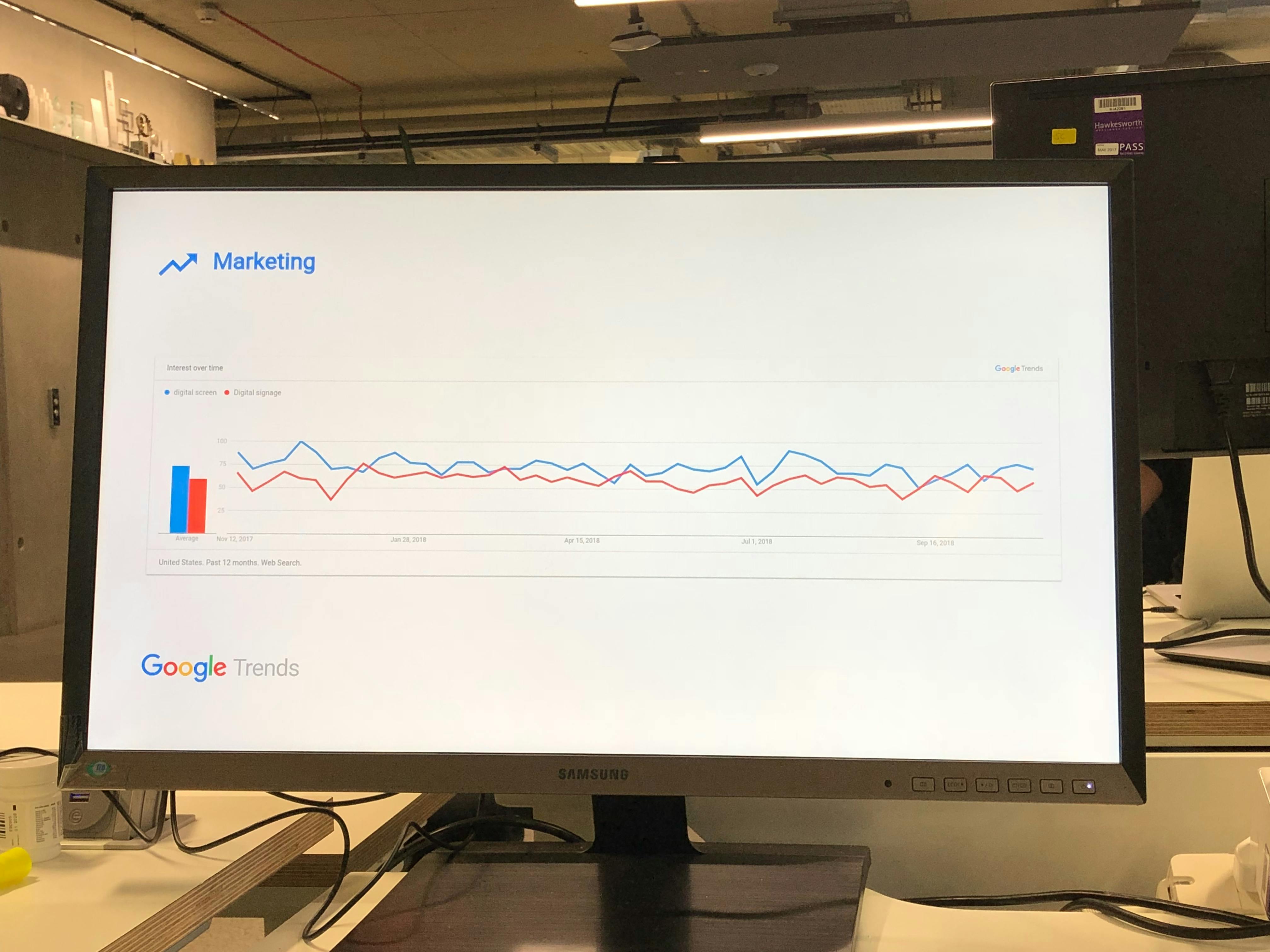
There’s a reason why billboard advertising has been one of the strongest methods of marketing for over a century. It works. Information we see or scan permeates our thought process.
Now imagine if you could do that within the workplace.
Digital signage benefits:
- Information can be updated and immediately deployed – no waiting for printouts or design
- Data you already have, like Zendesk customer service stats, or your number of Facebook page fans, can be connected to screen using apps.
- Screens radiate information that employees can consume while they work – they don’t have to read a handbook or open an email.
- Screens can be scheduled to play different content at different times
- Screens can solve the problem of silos across multi-location corporations
Digital signage tool example: ScreenCloud
With ScreenCloud you can share any content you like to your digital screens, through schedules and playlists. This allows you to take the most important information and give it an office-wide view. This could be in your office, team room, reception, lobby or even in the lunch café.

Why it’s a top app: ScreenCloud allows you to create content using over 60 different apps in the App Store such as social media feeds, news, world information and dashboards from customer support tools like Zendesk. Then you have playlists and scheduling, which allow you to create different content for different departments, days of week and times of day. As well as “emergency” takeovers where you can broadcast crucial information to your teams, as and when needed.
Get it on: iOS, Android and a ton of other devices listed here.
If this sounds like the tool for you, check out our free trial.
3. Instant messaging tools
What is an instant messaging tool?
An instant messaging tool allows you to communicate instantly and send messages of text, photos, videos or web links to other people within your company. It’s a faster and more natural way of communicating and closely mimics tools we use in our personal lives, like Whatsapp and Facebook Messenger.
When you craft an email, you know it’s going to sit in someone’s inbox and potentially be referred back to later in the day. With instant messaging, it’s instantaneous so you can give less thought to the way you say hello, or how you sign-off. Instant messaging channels are also set up for group discussions. For example, you may have one ‘room’ dedicated to Marketing and another for Sales. This allows everyone to share relevant information, without clogging up your inbox with emails.
Instant messaging channels often give you the power to integrate and automate useful information you have elsewhere. For example, we integrate our “Customer” channel on Slack with Close, so that when a new customer signs up we get notified in Slack.
If a company intranet is the “pull” method, where employees can search and pull out data, instant message channels are the “push”.
Instant messaging benefits:
- An agile way to share information and ask questions
- Lower volume email inboxes
- Open conversations that can be searched, rather than private conversations happening solely on email.
- Easy video and voice call access, often free across locations
- Ability to share documents, photos and videos in one place
Here’s what Slack, a popular instant messaging tool, looks like:
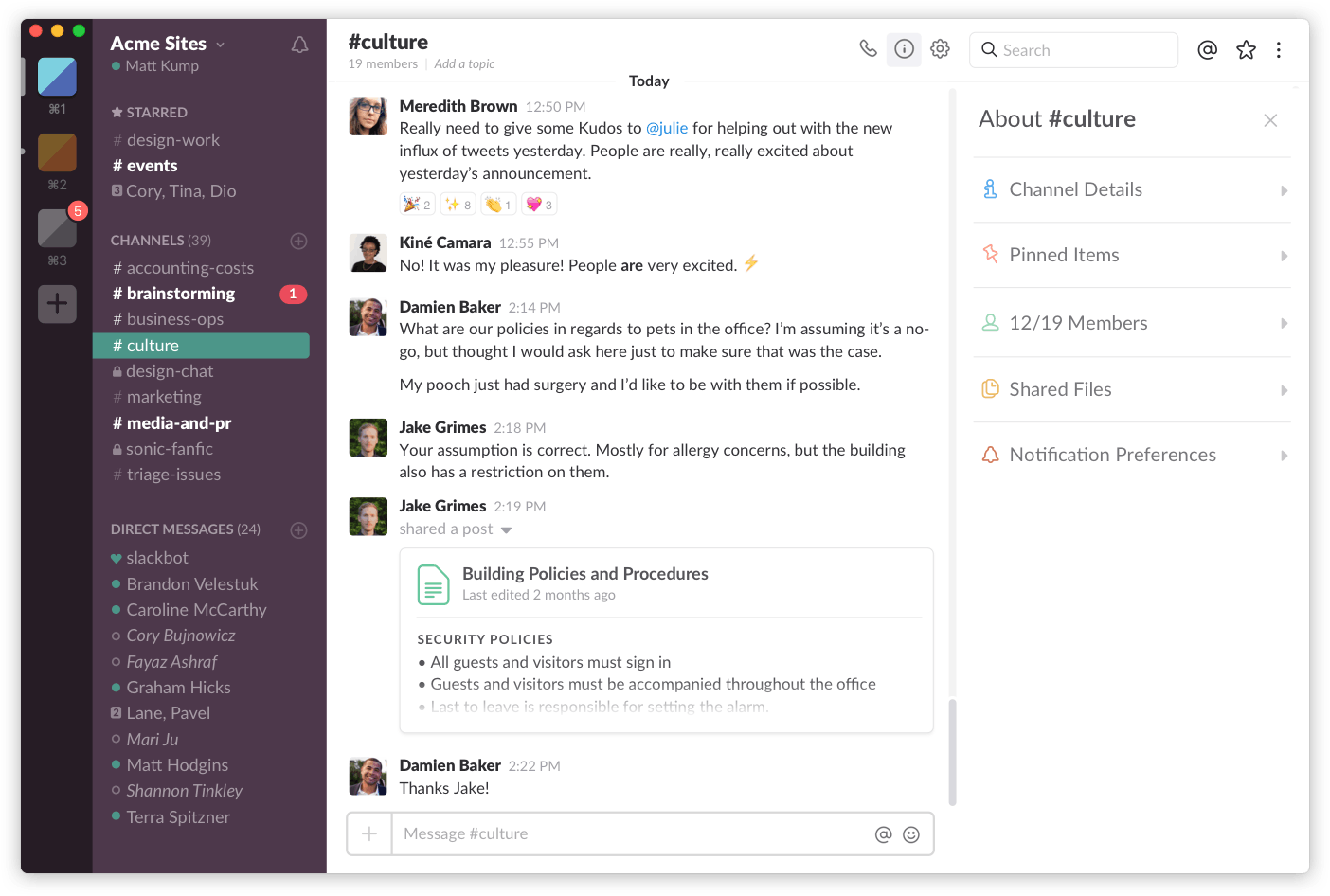
Instant messaging tool example: Flock
Slack has widely become the “go to” message app of choice for corporate comms but another we really like is Flock. This app is slightly easier to use than Slack and has all of the features you may need for sharing information with your team, fast. It also has to do lists, notes and integrations with your Google Drive, making pulling in and working on documents much faster.
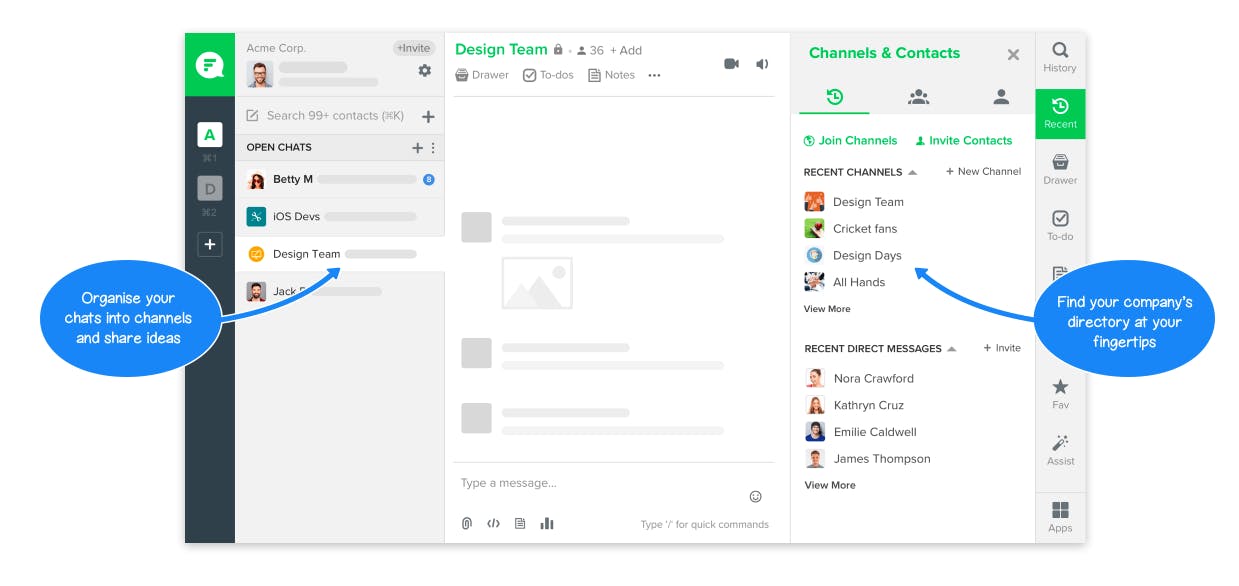
Why it’s a top app: Flock syncs really well across desktop and mobile devices so you don’t have to spend time scrolling through messages on your phone that you’ve already read. It also takes up way less storage than Slack, a nifty 21MB for the iOS mobile app, compared to Slack’s 66MB.
Get it on: iOS, Android and Desktop.
4. Collaboration tools
What is a collaboration tool?
A collaboration tools is any tool that allows more than one person access, in order to share a project, add feedback, notes or provide sign-off. Cloud-based software has changed the way collaboration tools are accessed. Many modern collaboration tools allow multiple users to access them simultaneously, and provide the features needed for changes to be tracked and to save different versions as the project evolves and changes.
Benefits of a collaboration tools for internal communication:
- Allows simultaneous users to access
- Increases collaboration
- Live changes and realtime feedback
- Easy to revert to previous projects, or changes
- One place to store all project notes
Why might you use a collaboration tool?
Not all companies use collaboration tools but those who do, find they have less email chains, more productive project management and security benefits, like locking a project down to just a few specific team members. Collaboration tools help you to monitor tasks, see progress and have version control over your documents.
Collaboration tool example: Google Docs
One of our favourite apps for getting stuff done at ScreenCloud is Google Documents. Perhaps the easiest way ever to create documents, spreadsheets or slides and share them with your team. With Google Docs everything is in the Cloud so you don’t risk losing your files and you never have to click “save”, because it does it for you.
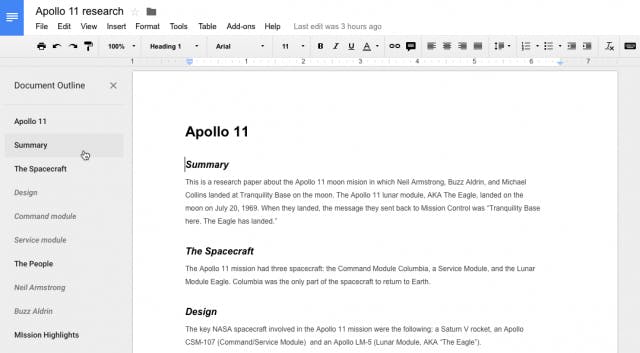
Why it’s a top app: Hard to believe, but Google Docs is 100% free. This means unlimited documents, spreadsheets, slides and forms are all easy to create, write and save. You can organize files by folder to make them really easy to find and there are a multitude of settings to allow your team to edit or just view.
Get it on: iOS and Android.
5. Employee social networks
What is an employee social network? (ESN)
Employee social networks are a relatively new tool for internal communication. Organizations can use the same features of a public social network to encourage employees to connect and discuss work-related topics. These might be spin-offs from a regular social media network, like Facebook by Work; or a standalone platform like Yammer. As with many communication tools, employee social networks overlap with other tools like instant messenger and company intranets. So why would you choose to start using one?
We think of it like this: if intranets are places for communication, channels like Slack are for collaboration. Then what about water cooler information? Especially in remote teams, team building and “getting to know each other” is essential but the information often seems too frivolous to post into Slack or to share on email.
This is one area where employee networks come into their own and provide a space for team building that otherwise wouldn’t happen.
Many organizations also see their employee social network as more than just a “nice to have”. Using them to share events, company blogs, and all of the information an employee needs access to. In this way, a social network can become a hub which allows employees to be more expressive and creative.
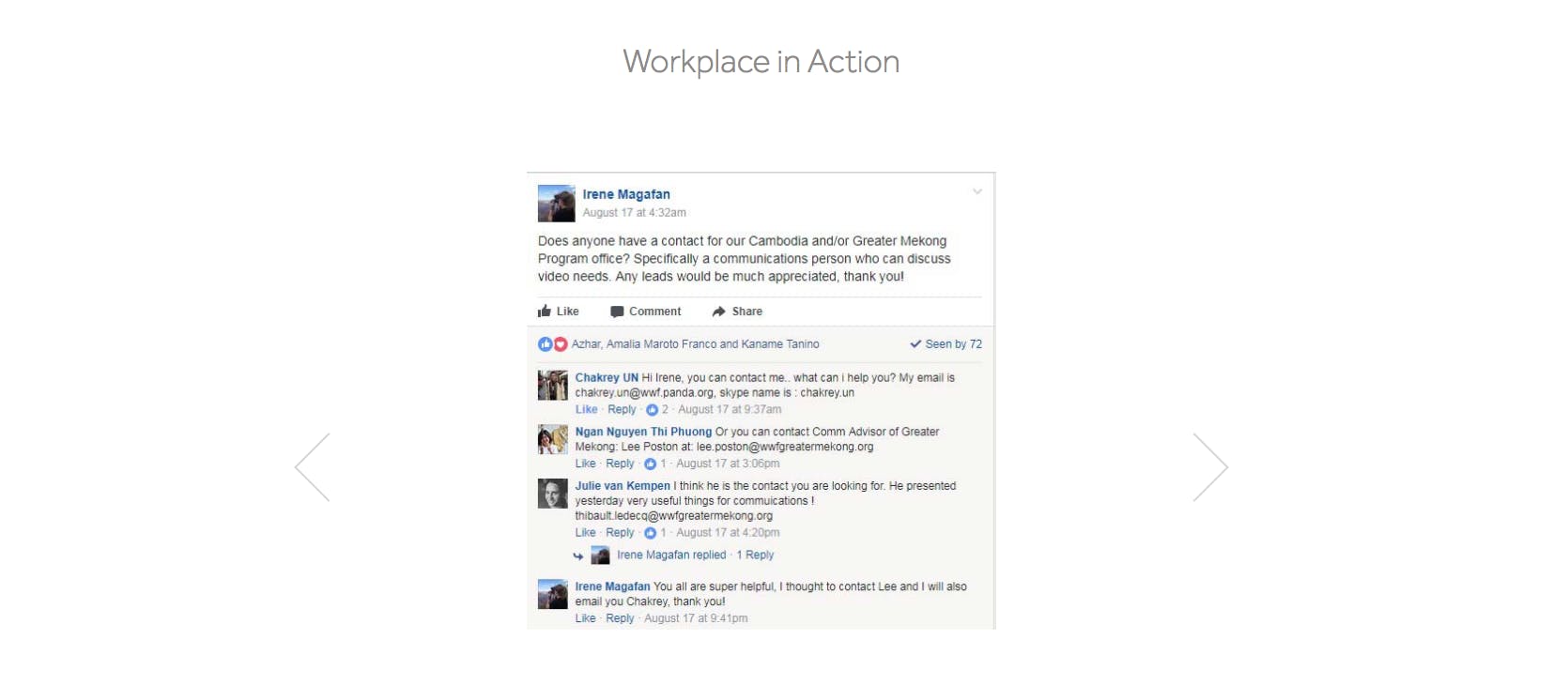
Workplace by Facebook in action – image source.
Benefits of an employee social network:
- Mimics natural behaviour – most employees are regular social media users in their personal lives
- Provides an instant way to ask for advice, get feedback or collaborate on tasks
- A way to build community between employees who may not work in the same office
- Build transparency by sharing employee praise, recognition and project updates
- A place for employees to discuss shared interests, work-related or otherwise
Employee social network tool example: Jostle
Jostle is an example of an employee social network. It labels itself as a “People Engagement Platform” containing tools such as a blog-led news feed and a “Shout out” section for employee praise.

Why it’s a top app: Jostle is a modern day employee network tool which means it’s easy to navigate and is simple for any team member to get to grips with. They’re also big on updating the product suite and adding new features, so there’s always something new to see and a better way to manage your internal communications.
Get it on: Browser, iOS and Android.
6. Team bonding tools
What is a team bonding tool?
Many companies view internal communication as something that’s top down, from the directors of the company to the employees. But what about lateral communication? The way employees communicate with each other is conducive to great work. That’s why tools that actively encourage employees to communicate more effectively are so important. One we have been trying recently at ScreenCloud is Donut, where two employees are randomly matched to take part in a “get to know each other” Slack call. Employee team bonding tools are useful for companies that have a partly or fully remote team. They’re also useful for teams where communicating may not come as naturally, for example in Development teams where most energy is spent on solitary coding, rather than communication.
Tools like Donut aren’t “magic cures” for companies where there’s a culture issue or low employee engagement, but they can help employees to feel more engaged and invested in their colleagues. After all, it’s pretty hard to dislike someone who has a pet cat called Wallaby.
Benefits of a team bonding tool:
- Helps employees that might not usually speak to connect
- Increases visibility across the organization of job and project roles
- Builds stronger connection between employees
- Makes communication easier
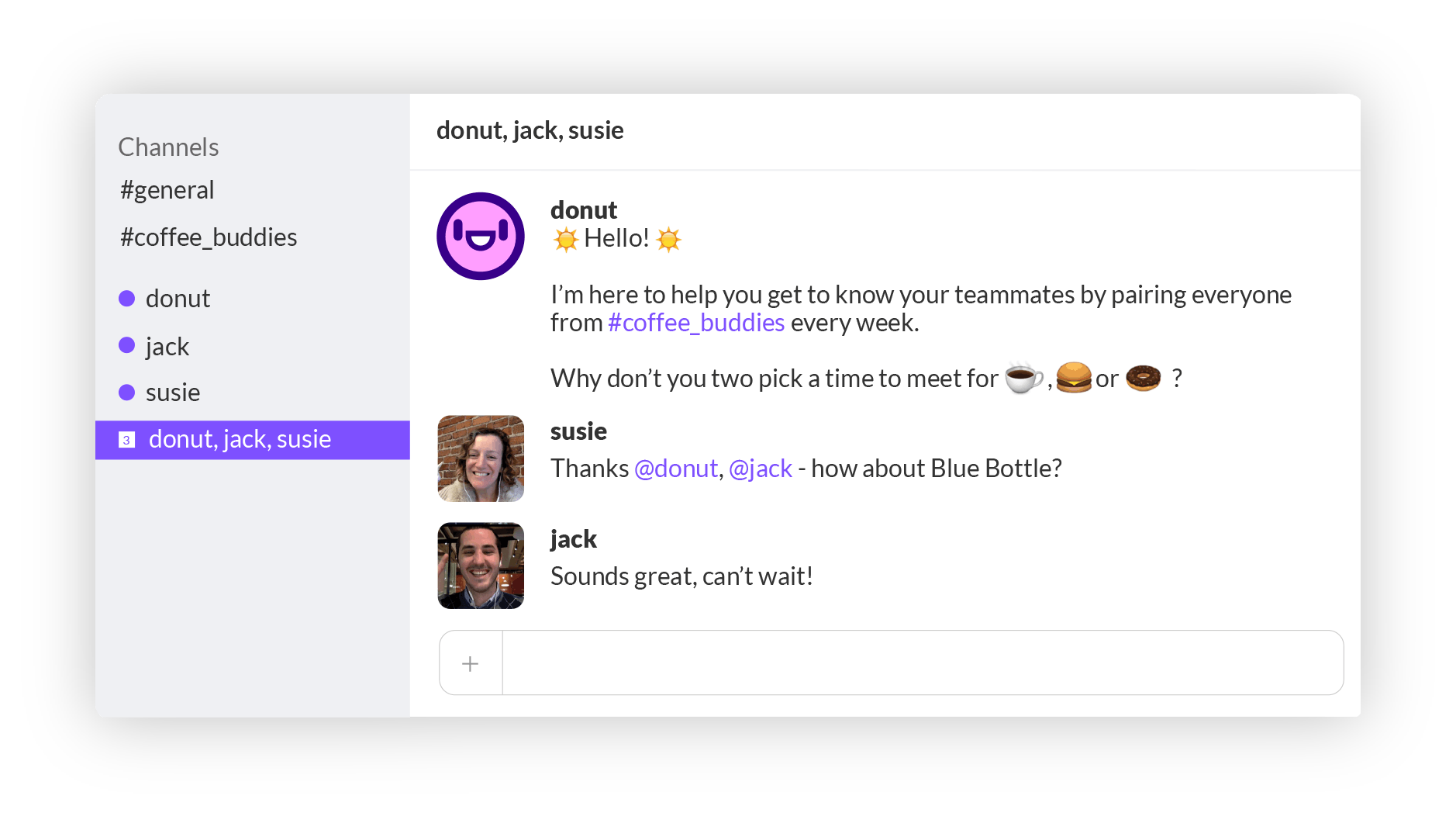
Team bonding tool example: Know your Team
An example of a team bonding tool is Know Your Team, which provides icebreaker questions for new team members and can be programmed to ask one non-work-related question each week, like “What’s your favorite family tradition?”.
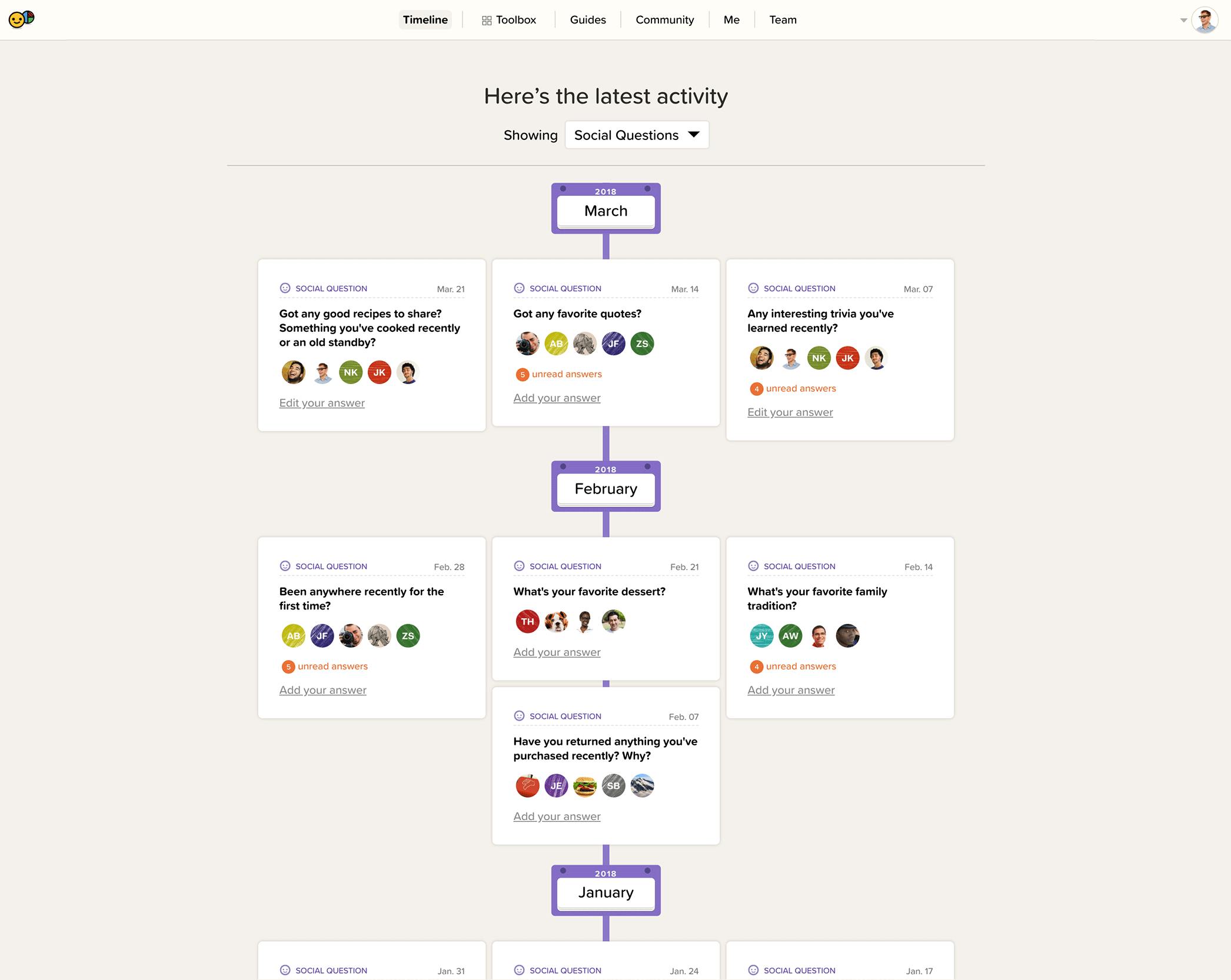
Why it’s a top tool: Know Your Team focuses on making good management easy. This translates into simple guides for managers that are scannable and pre-set questions (150+ of them!) that help you to get to know your team, without having to spend time and energy thinking of icebreakers.
Get it on: Browser
7. Video chat tools
What is a video chat tool?
A video chat tool allows different people to connect via a voice call, or voice and video call, via the internet. Examples of video chat tools include Skype, Zoom and PowWowNow. With many teams located across continents, or different offices, internal communication often means transatlantic communication. Teams that need to communicate regularly need the tools to be able to do so effectively. This is where video chat tools come in as an important part of the internal communication arsenal. Without a way to create virtual meetings, teams are restricted to written communication and we all know that sometimes you need to get face-to-face (or screen-to-screen) to thrash an idea out.
Benefits of a video chat tool:
- Helps employees connect visually
- Gives everyone the same tool to adopt
- Often free, or more low-cost than actual phone calls
- Cloud-based
- Low point of entry to join
Video chat tool example: Zoom
Zoom is a web and video conferencing tool that makes video calls (often filled with technical problems), easy. Whether you’re having a multi-person meeting or trying to give a video webinar to customers, Zoom gives you the tools needed to succeed. Zoom meetings are easy to setup, run through the app and can be shared with those outside of your office with a simple link. Once that person is in your “room”, you can share screens, talk over video and send messages.
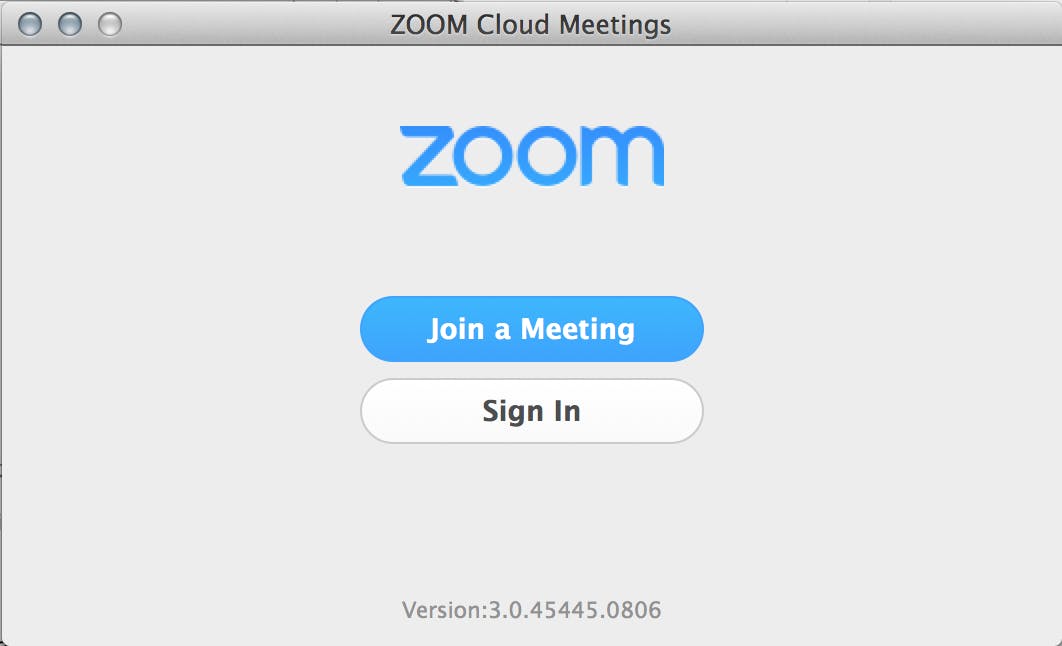
Why it’s a top app: Zoom works across Mac, Windows, Linux, Chromebooks, iOS and Android and does one important thing: it makes video conferencing work. The ability to call or schedule a meeting with anyone, whether in your organization or not, makes this a no brainer for improving the way you and your team communicate
importance of communication tools
1. A Social Intranet
For people in a modern organization to actually engage, contribute and learn, they need to be less rigid.
We’re talking about teams having less structure, so they feel free to contribute, grow, and be creative in their work-life in a way that creates a community vibe. A top-down information tree doesn’t work for modern employees—but social tools do.
Investing in a social intranet is a way for your company to create a democratized communication platform that allows your people to talk, contribute, comment, share, and bond on their own terms. The more social your team is at work, the more freely they’ll communicate about not just tasks but also their lives.
This creates a deep bond within your team that’s hard to replicate, and it can create a ripple effect on everything from how happy they are to increased productivity and higher retention levels.
Social intranets are also a great way to plug common holes in a communication strategy, like:
- Disengaged teams with dipping morale
- Overflowing inboxes with unread company announcements
- Disjointed communication workflows (where should your team talk…email? Slack? WhatsApp?)
The reason social intranets are an ideal tool to fix these issues is that they are so familiar. For example, a tool like Workvivo mirrors common social media platforms and has everything from automated activity feeds to status updates:

Here, employees can join in (or start!) the conversation and keep up-to-date with what the rest of the team is discussing. Not only is this a perfect way to build company culture, but it also gives your team a chance to get to know one another on a deeper level and learn about each other’s values and interests.
You can track how well your social intranet is working, too. Workvivo has a dedicated dashboard that lets you see how engaged your team is, what posts they are responding to, and when they are interacting with posts.

Like what you see? If you want to try out a social intranet in your workplace, take Workvivo for a test spin here.
2. Task Management
Dispersed and remote teams don’t have the luxury of popping into each other’s offices to see what their colleagues are working on or check up on a deadline.
That’s why task management tools are so important. Your company can have the most sophisticated tech stack, but it’s almost impossible to accomplish your goals if its tasks are not properly managed.
With a task management tool, you can create project calendars, assign tasks to team members, and set due dates. Once a project kicks off, the tool will track how projects are progressing and if your team is sticking to the schedule.
Task management tools are also perfect for managing discussions about projects, as every comment or piece of feedback made is kept inside cards or threads. For example, a tool like Asana keeps projects organized using dedicated lists, boards, and timelines:
If your team has a question about a task or needs to change a due date, all they need to do is @mention you, and you’ll get a notification.
3. Instant Messaging
Instant messaging is an essential tool for fast-paced teams who need to communicate and collaborate in real-time.
While email is supposed to do this, we all know its flaws: messages are only read if someone is constantly checking their inbox. And even then, our email will probably get lost if our colleagues’ inbox is overflowing.
Instant messaging tools are the ideal solution for teams stuck in unnecessary email threads or who want to collaborate in real-time without dealing with the time lag that comes inboxes.
One of our favorite tools is Slack. It’s a simple, easy-to-use instant messenger that you can use to communicate individually or on team threads in real-time.
Our favorite feature in Slack is the #channels feature. Channels can be created for different teams, so your design team doesn’t hear what invoices the finance department is chasing, and they’re also a great place to increase productivity. Instead of hauling your team in for lengthy morning meetings, you can use Slack’s morning stand-up feature to get a quick rundown of what everyone is working on that day:
Pro-tip: If you use Workvivo for your social intranet, you can take advantage of Slack’s instant messaging features by integrating the app into your activity feed. So even when your team doesn’t have Slack open, they won’t miss out on any important messages!
4. Voice & Video Conferencing Tools
Over the last year, we’ve all adjusted to meeting with each other through a screen rather than in person—and this trend is likely to stick.
Adding voice and video conferencing tools to your tech stack is a must. These tools aren’t just a way for your team to meet up and discuss projects, but they’re also a perfect solution to talking to customers remotely and networking with potential clients.
Depending on what tool you choose, setting up a video call with your team is as easy as setting a meeting time, sharing a link with them, and waiting for them to join. A tool like Zoom (which now has over 300 million users!) allows you to host meetings, share presentations, and connect with clients from anywhere.
Just sign up for a (free!) account—and get chatting.
Once the meeting starts, you can share your screen and link files with up to 25 team members. And if somebody can’t make the meeting, you can record it and send it to them once you’re done!
Nice to know: If you are using lots of apps, it’s hard to keep track of them all. Thankfully using a tool like Workvivo, you can use the App Launcher to integrate and use apps straight from the dashboard. Zoom’s integration with Workvivo allows your team to launch video meetings directly from their social intranet, saving them the time of switching between applications.
5. Document Collaboration Tools
Collaboration tools are a must-have for any team.
Picture what a workspace would look like without a document collaboration tool—how is it possible for a team to join forces and work together on a project without them? There are plenty of document collaboration tools to choose from, and the best part about it is—lots of them are free.
We recommend a suite like Google Workspace, which allows teams to collaborate on documents, spreadsheets, slides, and forms. You can simply share a link with a teammate and then comment, make suggestions, and edit projects in real-time.
6. Knowledge Center Tools
Educating your team about as many aspects of your company as possible is a great way to motivate them and build up their knowledge about your product.
The hard part is finding the time to educate them. Holding meetings and sending out hefty information packs isn’t the best way to motivate them to learn more about your company and empower them to solve problems on their own.
But one tool that can do all that is a knowledge center.
A knowledge center, or “base”, is basically a library where companies can store policies, training documents, wikis, and much more. It’s also a place you can make company announcements, update mission statements, and brainstorm company goals.
A communication tool like Notion allows you to build an organized knowledge base and easily update documents when needed.
And if you are in the early stages of creating a knowledge center, it’s perfect for that too. When you are writing guides, you can tag-team members into the document and ask them whether or not anything should be added:
Once all the guides are finished, the rest of your team can self-diagnose problems and use the knowledge base to freshen up on policy and culture standards.
7. File Sharing Tools
Collaboration tools are one thing, but you need to be able to share files with the rest of your team as well.
Without a way to share files, your team is at the mercy of relying on email to share and manage documents. Not only can this hurt productivity, but it also makes it easier for files and folders to get lost in inboxes.
Adding a file-sharing tool to your communication tech stack allows your team to link files and folders using a simple URL link. For example, using a tool like Dropbox, you can use a secure link to send anything from images to videos and zipped folders to anyone on your team.
And unlike email, there’s no file size limit, so you can share large files without having to worry about condensing them and losing quality.
8. Employee Directory Software
Building a good team environment starts with getting to know each other.
It’s almost impossible to do that if you are working in a dispersed or remote company and you don’t know the roles and responsibilities of everyone on your team. Even for small businesses, each team member must know the organizational layout and hierarchy of the company, so they know who to contact when they have a question or need information.
The solution? Using an employee directory.
They work like an old-fashioned Rolodex: they keep information about each employee, their role, responsibilities, and place in the company’s organizational structure. Each employee will also have a picture of themselves (so they’re easier to recognize in Zoom meetings!) and contact information to make it easy for other team members to reach out to them if they need to.
If you are already using a tool like Workvivo for your social intranet, the good news is employee directory software is included. With Workvivo’s People Directory and Organizational Chart, your team can use the search feature to find the right person to contact.

9. Internal blogs, videos & updates
If your team isn’t interacting with internal content and lacks knowledge about products and announcements, alarm bells should be ringing.
A warning sign that your internal communications are in trouble is if your team just isn’t interacting with the content you are sharing with them. Part of the problem is that businesses don’t treat internal marketing with the same importance as marketing to customers, which Harvard Business Review says is a mistake. In his essay “selling the brand inside,” Colin Mitchell says that it’s hard for employees to emotionally connect to the products they are selling without internal marketing.
“Without that connection, employees are likely to undermine the expectations set by your advertising.”
“In some cases, this is because they simply don’t understand what you have promised the public, so they end up working at cross-purposes. In other cases, it may be they don’t actually believe in the brand and feel disengaged or, worse, hostile toward the company. “
You can overcome this by creating internal content like internal company blogs, videos, and podcasts that are just as interesting as the content you would produce for customers. By creating training videos and interactive podcasts, you can boost content engagement and directly link your C-Level leadership to every employee in the company.
10. Analytics
A big part of getting your internal communications right is knowing what content your team is actually reading.
If you are in the dark about how engaged your team is, it’s hard to know what type of content they want to consume and whether or not your current efforts are going to waste. Adding an analytics tool to your tech stack can help uncover sentiment and show how happy your team is and learn about their behaviour when interacting with content.
Using pulse surveys, for example, can give you an insight into everything from how engaged your team is to how much trust they have in your company and how satisfied they are with their overall role.
11. Discussion forums
Sharing information and discussing solutions to problems is essential to team growth and productivity.
The problem for some workplaces is that they lack the space for these discussions to happen. Without a dedicated space, it’s hard for employees to ask questions, share knowledge, and talk about new ideas and trends.
Building discussion forums can solve this. Discussion forums are like micro-communities where your team can talk about common interests, share perspectives, and encourage creativity. They don’t have to be all about work, either. Discussion forums can be used as a community-led approach to communication where your team has a place to just bond and talk without being tied to productivity or projects.
At Workvivo, we use discussion forums, called Spaces, to talk about everything from culture and diversity to events and social activities.
Spaces allow people from across the organization to collaborate around topics on a whole different level. Much more effective than your instant chat channel!
Share knowledge, brainstorm, or ask questions in these common interest groups.
Spaces can be public, private, mandatory, or optional.

12. Email management
Whether you like it or not, email has its place in every company.
The problem with how email is used in modern workplaces. Some companies use internal blast emails from faceless CEOs to share company news or make product announcements (which unsurprisingly are mostly ignored.) And CC’ing and BCC’ing in colleagues is a sure-fire way to get communication buried in a busy inbox.
With the right communication tool, you can reimagine the place email has within your tech stack. For example, email management tools like Rooftop allow your team to work within shared inboxes and collaborate on customer emails.
You can even set up rules, so emails are automatically routed to the correct person, and instead of CC’ing and BCC’ing a team member, @mention them so they’ll get the memo!
Conclusion
Let us know your thoughts in the comment section below.
Check out other publications to gain access to more digital resources if you are just starting out with Flux Resource.
Also contact us today to optimize your business(s)/Brand(s) for Search Engines
